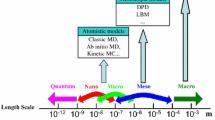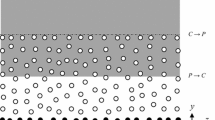Abstract
Mesoscale dispersed two-phase flows often involve complicated dynamic behaviors. Grid-based methods within the framework of continuum mechanics are usually difficult to capture certain degree of molecular-level effect, while the molecular dynamics is only practical at extremely small temporal and spatial scales. In this paper, dissipative particle dynamics (DPD) is extended to the investigation of a fluid–solid sphere system with inertia effect within two parallel plates through the modification of DPD weighting function and hence the dynamic parameters. The sphere and walls are composed of frozen DPD particles that are first treated to reach equilibrium state in the simulation. The force on the solid sphere is obtained from all the particles included in the sphere. The drag coefficient of the frozen sphere is evaluated and compared with the classical correlations. The initial value problem for the sedimentation of the sphere is then solved at certain Reynolds numbers, which is consistent with our direct numerical simulation results.








Similar content being viewed by others
References
Anurag K, Yutaka A, Eiyad AN, Manfred K, Mohammad F (2009) From dissipative particle dynamics scales to physical scales: a coarse-graining study for water flow in microchannel. Microfluid Nanofluid 7:467–477
Batchelor GK (1967) An introduction to fluid dynamics. Cambridge University Press, Cambridge, pp 174–255
Bird GA (1963) Approach to translational equilibrium in a rigid sphere gas. Phys Fluids 6:1518–1519
Boek ES, Schoot HNWP (1998) Resolution effects in dissipative particle dynamics simulation. Int J Mod Phys C 9:1307–1318
Boek ES, Coveney PV, Schoot HNWP (1997) Simulating the rheology of dense colloidal suspensions using dissipative particle dynamics. Phys Rev E 55:3124–3133
Brown PP, Lawler DF (2003) Sphere drag and settling velocity revisited. J Environ Eng 129:222–228
Chang JZ, An K, Liu HT (2010) The study of the sedimentation of solid particle influenced by thermal convection using direct numerical simulation. Chin J Theor Appl Mech 42:205–211
Chen S, Phan-Thien N, Khoo BC, Fan XJ (2006) Flow around spheres by dissipative particle dynamics. Phys Fluids 18:103605–103605-14
Espanol P, Warren P (1995) Statistical mechanics of dissipative particle dynamics. Europhys Lett 30:191–196
Fan XJ, Phan-Thien N, Yong NT, Wu XH, Xu D (2003) Microchannel flow of a macromolecular suspension. Phys Fluids 15:11–20
Fan XJ, Phan-Thien N, Wu XH, Ng TY (2006) Simulation flow of DNA suspension using dissipative particle dynamics. Phys Fluids 18:063102
Feng J, Joseph DD (1995) The unsteady motion of solid bodies in creeping flows. J Fluid Mech 303:83–102
Feng J, Hu HH, Joseph DD (1994) Direct simulation of initial value problems for the motion of solid bodies in a Newtonian fluid Part 1. Sedimentation. J Fluid Mech 26:95–134
Giacoma A, Dureisseix D, Gravouil A, Rochette A (2014) A multiscale large time increment/FAS algorithm with time-space model reduction for frictional contact problems. Int J Mult Comp Eng 97:207–230
Groot RD, Warren PB (1997) Dissipative particle dynamics: bridging the gap between atomistic and mesoscopic simulation. J Chem Phys 107:4423–4435
Hoogerbrugge PJ, Koelman JMVA (1992) Simulating microscopic hydrodynamic phenomena with dissipative particle dynamics. Europhys Lett 19:155–160
Kim JM, Phillips RJ (2004) Dissipative particle dynamics simulation of flow around sphere and cylinders at finite Reynolds numbers. Chem Eng Sci 59:4155–4168
Kim BH, Beskok A, Cagin T (2008) Thermal interactions in nanoscale fluid flow: molecular dynamics simulations with solid-liquid interfaces. Microfluid Nanofluid 5:551–559
Liu HT, Chang JZ (2013) The implement and influence of different boundary conditions in direct simulation on particle sedimentation. Acta Phys Sin 62:084401
Liu GR, Liu MB (2003) Smoothed particle hydrodynamics—a meshfree particle method. World Scientific, Singapore, pp 10–20
Liu MB, Meakin P, Huang H (2007) Dissipative particle dynamics simulation of fluid motion through an unsaturated fracture junction. J Comput Phys 222:110–130
Low CP (1999) An alternative approach to dissipative particle dynamics. Europhys Lett 47:145–151
Marco K, Dimitris D (2011) Multiscale simulation strategies and mesoscale modeling of gas and liquid flows. J Appl Math 76:661–671
Marsh CA, Backx G, Ernst XH (1997) Static and dynamic properties of dissipative particle dynamics. Phys Rev 56:1676–1691
Revemga M, Zuniga I, Espanol P (1999) Boundary conditions in dissipative particle dynamics. Comput Phys Commun 121:309–311
Shan XW, Chen HD (1993) Lattice Boltzmann model for simulating flows with multiple phases and components. Phys Rev 47:1815–1819
Acknowledgments
This work is supported in part by the National Natural Science Foundation of China (Grant Nos. 51476150, 11102185 and 11232003), the US. Defense Threat Reduction Agency under grant number HDTRA1-10-1-0022, Funds for International Joint Research Program of Shanxi Province, China (Grant No. 2014081028) and Scientific and Technological Innovation Programs of Higher Education Institutions in Shanxi.
Author information
Authors and Affiliations
Corresponding author
Rights and permissions
About this article
Cite this article
Liu, H., Jiang, S., Chen, Z. et al. Mesoscale study of particle sedimentation with inertia effect using dissipative particle dynamics. Microfluid Nanofluid 18, 1309–1315 (2015). https://doi.org/10.1007/s10404-014-1529-1
Received:
Accepted:
Published:
Issue Date:
DOI: https://doi.org/10.1007/s10404-014-1529-1




